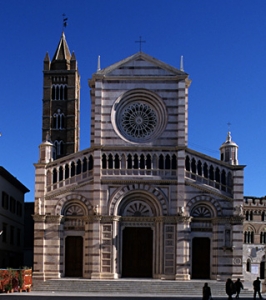Grosseto
The wild character of the Maremma is typical of southern Tuscany, with its rugged landscapes speckled with Butteri, Maremma cowherds. The Roman presence, still visible today at major archaeological sites such as Vetulonia, Populonia and Roselle, initiated the development of the coast and of the spa centres, among which Saturnia is without question the most famous. Sienese domination contributed instead to the development of new centres in the hinterland, connected to the exploitation of mines during the period of the so–called "battlements", of which Massa Marittima is important testimony. Florentine domination and the contemporaneous Spanish interlude were focused on coastal defence, resulting in the fortification of Talamone, Orbetello and Porto Ercole. The old problem of the reclamation of the marshlands, begun by Pietro Leopoldo, could only be considered concluded after the fascist period: a process of territorial and economic transformation – new crops were made possible and new infrastructures were built – was thereby triggered, with the emergence of new urban centres. The effects of urbanization following the reclamation are especially evident along the coast, so much so as to make tourism the primary economic motor of the Maremma, with its renowned resorts peppering the coast, from Punta Ala to the Argentario.
The creation of protected natural areas has been fundamental to preserving the typical character of these places: among these, and closely connected to the Napoleonic period and Elisa Baciocchi’s rule, is the Parco Interprovinciale di Montioni, with ancient settlements connected to mining. The relationship between this area and the French rulers was at first encumbered by major tensions, as testified by the revolts that took place between 1800 and 1801 in Prata di Massa Marittima. During that period the locals repeatedly ambushed the troops from north of the Alps, in a crescendo of tension that was only resolved with the issuing of amnesty for the insurgents by Gioacchino Murat, French commander in Tuscany at that time.










